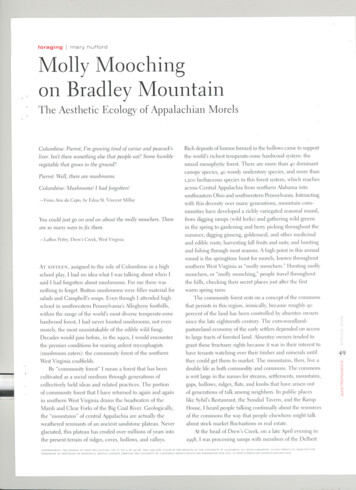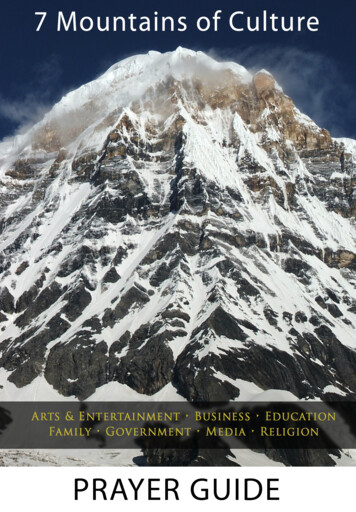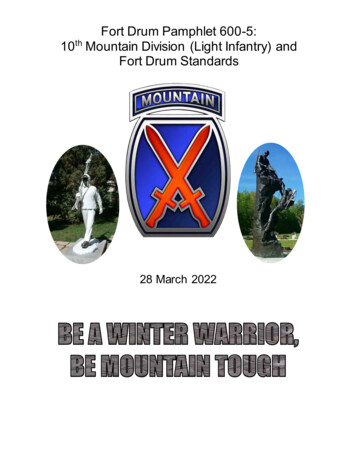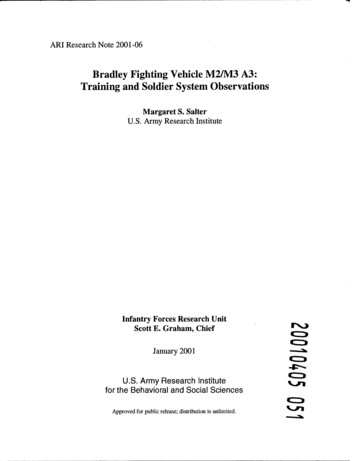
Transcription
-"".-.:. .!I.Io.;.;. .--. . .:.o. .L . "'-'. .)'"' \. . .,f'0#'1,foragingImary huffordMolly Moochingon Bradley MountainThe Aesthetic Ecology of AppalachianColumbine:Rich deposits of humus formed in the hollows came to supportPierrot, I'm growing tired of caviar and peacock'sliver. Isn't there somethingthe world's richest temperate-zoneelse that people eat? Some humblecanopy species, 40 woody understoryPierrot: Well, there are mushrooms.Mushrooms!1,200 herbaccousacross CentralI had forgotten!southeastern-FromhardwoodAria cia Capo. by Euna St. Vinccnt Millaysystern: theforest. Therc are more than 40 dominantmixed mesophyticvegetable that grows in the ground?Columbine:Morelsspecies, and more thanspecies in this forest system, which reachesAppalachiafrom northernOhio and southwesternAlabamaPennsylvania.with this diversity over many generations,munities have developeda richly variegatedcom-seasonal round,from digging ramps (wild leeks) and gatheringare so many ways to fix them.in the spring to gardeningsummer;InteractingmountainYou could just go on and on about the molly moochers. There- T,affon Pettry, Drew's Creek, West Virginiaintowild greensand berry picking throughoutdigging ginscng, goJdenseal,and ediblc roots; harvestingtheand other medicinalfall fruits and nuts; and huntingand fishing through most seasons. A high point in this annuaJround is the springtimeAT SIXTEEN, assigned to the role of Columbineschool play, I had no idea what I was talking about when Imoochers,said I had forgotten about mushrooms.the hills, checkingnothingto forget. Button rnushroomssalads and Campbell'sFor me there wasPennsylvania'sI attendedAlleghenyor "molly mooching,"(-hlllting mollypeople travel throughoutthcir secret placcs just after the firstwarm spnng rams.wcrc filler material forsoups. Even thoughschool in southwesternhunt for moreJs, known throughout'Nest Virginia as "molly moochers."southernin a highThe communityhighforest rests on a conccpt of the commonsroughly 90that persists in this region, ironically, becausefoothills,within the range of the world's most diverse temperate-zonehardwood forest, I had never hunted mushrooms, not evenpercentof the land has been controlledmorels, the most unmistakablepasturelandsince the late eighteenthof the edibJe wild fungi.by absenteeownerscentury. The corn-woodland-economy of the early settlers dependedon acccssDecades would pass before, in the 1990S, I would encounterto large tracts of forested Jam!. Absentee owners tended tothe premiergrant these fructuaryconditions(mushroomfor rearing ardent mycophagistseaters): the communityforest of the southerncultivatedthroughgenerationsheld ideas and related practices.of comn1Unity forest that I have returnedin southerndouble life as both commodityforest" I mean a forest that has beenas a social mediumcollectivelyit was in their intcrest toover their timber and minerals untilthey could get them to market. The mountains,West Virginia coalfields.By "communityrights bccausehave tenants watchingThe commonsis writ large in the names for streams, settlements,ofof generationsto again and againof talk among neighbors.like Sybil's Restaurant,of theIn public placesI-louse, I heard people talking continuallythc "mountains"of the commons the way that people elsewhereabout stock market fluctuations or real estate.weatheredremnantsof an ancientare actually thcsandstoneplateau.Never1998, I was processingthe present terrain of ridges, coves, hollows, and valleys.GASTRONO\.!ICA:PER I!SSIO",THETOJOUR1' .'\l,PHOTOCOI'YOFORFOODA' ;!JREI'ROI)[Jf:I':CUI.TtJRE,,"-RTICLEVO).CO TE;';T6,;';D.:.PI',THROlTGH49-')6,THEISS1' 1529-)26:,l':"IVERSITYOF(ej2006C!\LlFOR IAabout the resourcesmight talkAt the head of Drew's Creek, on a late April evening inglaciated, this plateau has eroded over milJions of years intoBY TilEPRESS'SREGF"TSRICHTSOFTHF:. ND\"IVERSITYPER !lSSIO;';SOFWFRC'\LIramps with rnembersFOR:" IA . "-1.1. ItlCHTSsnr"RESER\'ED.PLEASI,:, T \\\\'\\,lJCPRESS,ED\T/JOUR"AI.S/RICIITS.IIT\.!of the DelbertDIRECTALLRL!jllLSTS«u:;;ozoItI(f)«(')the Sundial Tavern, and the RampMarsh and Clear Forks of the Big Coal River. Geologically,of central Appalachiamountains,gaps, hollows, ridges, flats, and knobs that have arisen outThe portion\Vest Virginia drains the headwatersand commons.then, live a49FOR
Freewill Baptist Church.Ramps, wild cousins of the leek andtured at communityalready, rolled in flour and fried in butter. "Have you evercelebrationsthroughoutcommunitycenter known throughoutHouse. As we choppedslippery outer membranethe mountains.the next day at the PineKnob Ramp Supper, an annual fundraiserthat supports thethe valley as the Rampoff the rootlets and peeled away the(jokingly referred to as the "slimer")ozocrf(j) J:(')Judy asked. "Try one!" I poppedonecoating, the wrapping for delicacieszucchini,I knew well, such assquash blossoms, and oysters, and the satisfYingrelease of juices as I began to chew. But the flavor spreadingover my palate was not the flavor of any of those foods. ItLaffon Pettry reported that a neighbor;;;moochers?"into my mouth, not quite prepared for the sensations thatfollowed. There was the familiar texture of the butter-flavoredtime of molly moochers.of theirs hadfound fifty-six of them already.Uhadmollyfor the next day's feast, we were already caught up in the"I found one today," said Jenny Bonds, "a little tiny one." J:soaking in salt water, urged me to come back.Just up the hollow Judy and Wayne GriffY were eating theirsThese ramps would be consumed50moochersthe first of the wild edibles to appear in the spring, are fea-he find them at?" Jenny wanted to know."Behindour house used to be an old apple orchard,""He found thirty-sevenyesterday."for morels, "the QueenWithinsimmeringmolly moocherswerethe hills and hollows sur-invitationsin the space of an afternoon.no other, leaving me startled and eager for more. In Sundial,Randy and DebbieSprouse offered me molly moochersin butter. Ianotherplateful in the home of Dave and GlennaBailey."Here, hog this!" Dave invited me. I obliged.rounding the headwaters of the Big Coal River. Calling atthe homes of friends on Drew's Creek and in Sundial andStickney, I had multipleoil or liqueur. Intenselythe juices into a taste liketried again to identifY the salient flavor, nutty, light, savory,of the Molly Moochers!"days of this conversation,in hazelnutearthy, it gatheredbut ultimately elusive. An hour later, in Stickney, I was facingthinking of her niece's passionin skillets throughoutto perfectionchoicest cut of beef,that had been dipped in beer batter and sauteed"Gladys was finding them out there," volunteeredDelores Workman."Gladys," Laffon chuckled,marinatedbut ethereally"Where'dLaffon answered.was a series of hints, of the tenderest,to eat molly moochersJenny Bonds, who hadmollyI began asking questionsabout molly moochers,where and when to get them, what to do with them. I askedeveryone I talked to over the next few weeks. Two thingsstood out: the collective passion for molly moochers and anabundance of theories about where and how to hunt them.Molly moocherdiscourse opens a window onto the region's
history of settlement,by Germans,people call them 'merkles,'"Italians, and Irish. "SomeAbove: The harvest. Lcft: The communityMae Bongalis told me. "TheyABOVE:look like a corncob.""Some people call them 'sponges,'"said Elsie Rich, a descendantpioneer.of Floyd Williams,She had married an Italian immigrant,forest at the confluenceLEFT:PHOTOGRAPHPHOTOGRAPHBY \fARYBY LY!'iTIIAHUFFORDSCOTT:01997.EILERAMF:RIC.,,, 1995.FOLKLIFEAMERICA",CENTER,FOlKLIFEwho referred'TheyOFLIBRARYCO:- CRESSOFCO:' CRE Ssay there's a lot back on Molly Daniel's place,"Randy finished.gourmand Apicius. "How did they get the name 'mollymoochers?'" I often asked.been up in Dry Creek and Rock Creek.""But I've never hunted"Old timey people called them that," eXplained Mary Allen,an older woman herself, who grew up on PeachtreeCreek.up there," said Kay. "I've only"Is there more than one kind of molly moocher?""Oh yeah," replied Kay. "It depends"Maybe that's from the Irish," suggested a man wholived over on New River.I asked.on what kind oftree you find them under. Your avid mushroomhunter doesnot look at the ground but up at the trees. If you find themI heard talk about whereunder apple trees, they're white. If you find them underthey grow and how hard they are to find, unless you knowsycamore trees they're yellow."the local history and ecology. "Buddy, I'll tell you," said KayMiller, one evening in the Sundial Tavern, "if you comehome with some mushrooms,l.IRRARYCf:r- TER,an Englishto morels as spugna, a term used by the classical RomanIn every public establishmentofPeach Tree Creek and Drew's Creek."Some of them are cone shaped, some of them areround," suppliedman, you have been on a hunt.""I love them," agreed Randy Sprouse. "Deep fry them inbeer batter."Randy."If you find them on the top of the mountain,"Kay, "they're brown, or black. They'recontinuednot as good as theones you find down low.""They say there's a real good place up in Peachtree,"said Kay Miller."Up on Molly Daniel's place," began Randy, referring toa stand of old growth in Jarrold's Valley at the confluencethe Marsh and Clear Forks."They say up in PeachtreereiteratedKay.there's a real good bunch,"ofTaxonomy and DesireAmong mycologists morel taxonomyis unresolved.mycologist Tom Volk called it. Currentlump together species that were thoughtThus, for instance,"A mess,"thinking tends toto be distinct.the yellow morels, Morchella esculenta51
(found around orchards, elms, tulips, and ash trces), Morchelladame herself. Thoughdeliciosa (white morels found in associationit resonates with the interdependencehickory trees), and Morchellawith tulip andcrassiPes (the bigfoot moreland the commonsfound near sycamores) could be ecotypes of the same species,as could the black varieties, lvl. angusticeps,M. elata, andfor landscape,to the stalk at the base of the head. It favors grassywhich seeps intoare brimmingbration and reinforcementpinecone,same bowl. This is a commensalityThe Cherokee,who rolledand fried them, knew them as Ahawisayoniyusti,meaning"like a deer antler." Etymologya Europeansearch image within the name for the genus asterms includedrevcalsmOTHS,alluding to the(moTHs THbra). In their booktion of forest gifts throughtalk and the circula-the community,especially towho cannot get into the mountainsthemselves.The Silesian tale also bears on the etiology of the cravingfor morels, which, like tomatoes,fish, and other mushrooms,recognizedParmesanstimulatecheese, meats,what was officiallyin the 1980s as a fifth taste: umami.In 1908 aJapanese scientist, Kikunai Ikeda, of Tokyo Imperial University,Rolfe note that the word morchella first appearedsought to nnderstandin 1719. Europeanquite similar: morchella (Bulgarian),(French),and morchel (German).in the sci-names for the morel aremorkel (Danish), morilleThe Old High Germankonbu (Japanesedeliciousnessthe essence of deliciousness. Investigatingkelp), Ikeda isolated glutamatethe taste. Interestingly,our first encountermorha, which mcant "carrot" or "parsnip," was diminutizedin breast milk, which is rich in glutamates.to us that a particularto the mushroom,which the morel was regardedconveys the affection within Europe.The term "molly moocher"central Appalachia.from whichare particularlyvegetables,appears to be unique toPcrhaps "molly," the Irish nicknamefood containsnutritious,containingcompoundChemistry, Rotzoll, Dunkel,the region in the 1840S to work on the railroad. But that is,(L-glutamiccould mean to "mooch"To the question of what itmollies, we will return shortly.52containMorelsmore protein than mostnot found in any other food.and Hofmannnot only possess the weIJ-known wnami-likeFoodfound that morelstaste contributorsacid, L-aspartic acid, and succinic acid) but alsoa unique glycoside, which they namedS-morelid.Thus, morels may look like many things, but they taste onlylike themselves. The flavor of morels is so difficult to describebecauseEtiology and Taste;;:;Umami signalsvital nutrients.In a May 2005 article in the Journal of AgriculturalMary, is a play on the French morilla, which might havesounded like "Maria" to the ears of the Irish who came toof course, sheer speculation.with umami isalong with vitamins A, B, D, and K. Morels alsopossess a chemicalforas thetrigger and coined the term umami to describeto morhila in referencemorchel derives. The diminutive«of sharing in the life of theThe Romance of the Fungus World (1925), R.T. and F.W.entific literature(I)of social ties by eating out of theforested hills, which is verified throughmemberscollectivethat goes beyond the cele-locating an object of desire: sponge, honeycomb,brains, tulip morels, hickoryinto somethingmortal time and space. In this we glimpse aof the mountainsclues formorel's likeness to a mulberry(j)the individualwith search images and contextualwell. Early Germanr-helps to incorporatecommensalitythem in cornmealClthe head and mouth of the hollow, the spine of the ridge,that transcendsorchard mushrooms.in our termsthe neck of the woods, the gorge of the river. The metaphorinforms the variety of common names for morels. These namesmushrooms,expressionwhich we inhabit as a set of giant body parts:the scientific names for species esculenta and deliciosa, alsosnake head, haystack, corncob,that frames membershipof the body has long been applied to thecoHective, and it finds continuingA global passion for morel mushrooms,ozoThe metaphorfree" morel, is the only morel with the cap margin notattached«as an institutionof molly moochingin a larger social body.M. conica. A third distinct species, M. semi libera, the "half-woods and is often found near tulip poplars.uthis tale is not told in West Virginia,it is the flavor of morels. The only way to commu-nicate the flavor is by sharing the mushrooms.Morels are also alludedthe gourmetto as "dryland fish," as pleasing topalate as choice seafood. "Aren't they the bestthings you've ever eaten in your life?" exclaimeda youngwoman from Rock Creek. "You fry them up like oystcrs. I'veeaten them until I was sick." The distinctive look of thefleshy fungus is accountedfor in a Silesian tale of how thedevil, once in a rage, tore an old woman to shreds and scattered her parts all over the forest. Wherevermushrooma part landed, agrew, as wrinkled as the skin of the wizened LNotes from the Mycelial UndergroundA Brief Foray into Morel PhysiologyThe worldwidepopularityinto cultivatingthe fungus for commerce,of morels has stimulatedsteadfastly resisted domestication.Historically,have found limited ways to encourageeighteenth-centuryGermanyresearchbut the morel hasaficionadosmorels. Peasants inprized morels so much that
and the fuchsias of redbuds. A]ong the road, here and there,Above: Women in the Ramp House at the head of Drew's Creek,a forsythia (known ]ocally as "shower of go]d") or a quincepreparing(known as "fire on the mountain")Brown, Jenny Bonds, Peggy Gilfillen,marked the sites of for-PHOTOGRAPHramps for the annual Pine Knob ramp dinner: lvlableBY TERRYI::ILER 1995-A\!ERICA\;FOLKLlfEand Delores Workman.CE:\TER,LIBRARY01'CO:\CRESSmer homes. "Before we go any farther, I want to tell yousomething,"Woody Boggs announced.mountainto our left, he continued,Waving at the"All the trees on thisside of the mountain are made of wood." He paused foreffect. "And the trees on the other side are too."Turningleft into the Irene Hollow, we began a teepvVayne Place, where an old spring and orchard had been.Once, while the others hunted for molly moochers, I succumbedto the urge to write down the names of all the wildflowers Isaw: white and pink trillium(a]so called "mountain]ilies"ascent, lurching and creaking along the rutted, unpaved routeand "whippoorwills");crto the top of Brad]ey Mountain.the yellow blooms of trout lily, spice bush, and colt's foot;(j)road before they fixed it!" Woody commented54qo;;;ozocrf-(j)q(I)He downshiftedand throughscalloped"You should have seen thisagain, and we bounceda terrain of overwhelmingand serrated ridgelines,seriously.our way aroundcontrast, in view ofsheer drops into deepred trillium("stinkingthe blue blooms of stagger; the purple-huedBenjamin");leaves of redfern; the white blooms of blood root ("red puccoon")Dutchman's-breeches;sproutingand the silver-dappledcow parsnip ("woo]en britches").andleaves ofI saw Jack-in-thecrevasses, and the softer cleavages of hills and hollows inpulpit ("Indianan earlier stage of spring. Our first stop was at the charredginger, and an abundanceremains of a campfire,an orchid that, like many of the spring ephemera]sthere,gets the nutrientsthe workbeside a bowl-shapedcove.Even with an arsenal of search images, molly moochersare hard to recognize.Is that dark spot across the hollow ahusk of a nut or one of the black morels? Is the bulge beneaththe nearby leaves a yellow more] or a mayapple?it took my companionsmoochers.In the timeto fill their sacks, I found three mollyWe stopped at severa] other sites, includingthecucumber"),of endomycorrhizae.cohosh ("seng pointer"),wildof putty root ("Adam-and-eve-root"),it needs from the canopy throughI stooped to inspect a suspiciousbulge,peeling away leaf litter that cloaked an unfurling mayapple.The undersides of the dead leaves were laced with whitefilaments,mycelia caught in the act of digesting future habi-tat for hardwoods,spring ephemera]s,and molly moochers.
they set fire to the woods each year to stimulateduction, until the governmentmorel pro-banned the practice. IycologistTom Volk, who in 1992 mappedout the life cycle of themorel, argues that the reason morels are so difficult to cultivate health of the communitycentury, fanners grewtheir "heavy vegetables"The main part of therich "benches"structurenewgroundsfungus is an undergroundmycelium,microscopiccalled awhich feeds on dead and dying organisms (if it isor forms symbioticmycorrhizal-fromrelationshipsthe Greek111)'kes,with trees (if it ismeaning"fungus," andfallowing. Tom Volk found that both elm and apple trees(which can live for fifty years or more on steep slopes) formmycorrhizalas ubiquitousHealy, a mycologistat Iowa State University, explainedidenticalcan clone itself repeatedlycells that lengthenonly branchesnotandto create a network of mycelia."Each network may evcntuallythousandassociationswith morels. Apple trees were onceas newgroundsin the mountains.weigh several tons, forming,if one is willing to count such networks as individuals,theWilliam'sBranch of Peachtreeorchards that maturedwith the woods were prunedpremier spots for molly mooching.trees lose their spurs," cautionedsequoia trees," writes David White.moochersAttachingassociations are fundamentalthemselvesliving onand harin thosethey have"Oncethe appleKay Miller, "the mollystop coming."to forcst health.to the roots of trees, fungi obtain fromtrees the carbohydratesand gatheringareas. As the orchards have aged and declined,largest organisms on earth: "Larger than baleen whales orMycorrhizalan octogenarianCreek in the 1990S. Thevested for decades by people huntingbecome"I've seen abushels of apples come out of that hollow in oneseason," related Dennis Dickens,the strand. "The myceliumout," she pointed out, "It also connectsfuses with its own branchestoto formWhen theseof years, a farmerwould plant an apple orchard and let the field go into forestwhich are the most massive living componentme that a mycelium(corn, beans, and winter squash) onof soil high in the mountains."wore out" after a numberrhiza, meaning "root"). Forest soils are teeming with mycelia,of soils. Rosannethey need but cannot producethem-Molly Mooching on Bradley Mountainselves. In exchange, they enhance the tree's access to waterand nutrients in the soil. Recent research has shown that\Vbethermorels form mycorrhizalold orchards are, and the reason I went molly moochingassociationspine trees. Morels can also functiondead matter throughnal stomachs,hardwoodexuded enzymesconvertingwith apples, elms, andas saprobes, digestingthat act as tiny exter-it into the rich humus on whichforests depend.It gets throughwalnut-sizedthrough cloning.hard winters by forming the undergroundsclerotiumfarmers planted orchards with morels in mind ornot, morels are one reason people rememberBradley Mountainone spring afternoonand can start up again in the springwhere theonwith Dave Bailey;his son, Terry; and their friend Woody Boggs. We met at themouth of Hazy Creek, near a tiny settlementas Launa before the Raleigh-WyomingA, long as there is a sourcc of nutrition, the morel myceliumseems able to grow indefinitely undergroundwithto molly mooching.the first half of the twentiethcultivatedthe sclerotium.newgroundsforest fallow forms a historic backdropcyele not present inmushrooms:forest? In this partThroughis that there is a stage in the morcllifesaprobic)renamedit Edwight.Descendantsthat was knownCoal Companyof people who settledLauna still live there. Dave and Terry climbedinto the backoNwith the tape recorderCDrunning.It was the morning after awarm spring rain. "It has to be a warm rain," Dave Baileybody. While it is easy to get the sclerotiumto producesaid. "It can't be the cold May rains. Those are different." Itit is extremely difficulthad to be the kind of rain, as Woody put it, where you couldmycelia under controlledconditions,appears to producedisruption-athe fruiting body in response to habitatforest fire or the death of a plant partner. Thisis why morels are so often found on burnedaroundThe primacy of apple orchards in molly moochingthe interactionsif you will, of homo mycorrhizalof humansinvitesassociations,with fungi and trees withinthe context of the communitypop out of the ground. "You canhear them pop up in a thunderstorm,"we drove, in pursuit of the cacophonousboth devastatedold orchards and dying elms.the investigation,hear the molly moochersBradley Mountain,ground andhe insisted. So offtoadstools.in the late twentiethcentury, wasand bursting with life. People had movedaway decades ago but returnedyear after year to harvestLige Bradley's Wolf River apples and prune the trees. Thescars of logging roads and strip mines visible on the mountainforest system. How do fungislopes were mitigatedby the color slowly bursting into viewinteract with collectively held values that govern the plantingaroundand harvestingset blooms of hard maples, the white blossoms of dogwoods,of trees? What is the role of mycophiliain of \Voody's pick-up truck, while I rode along in the cab,either by forming new mycelia or by scnding up a fruitingto get it to produce a fruiting body. In the wild the sclerotiumi'!the continuingofVv'est Virginia, the practice of alternatingthem: the green buds of soft maples, the orange rus-ZO'co.U)53«uLoZoa:I-(f)«(')
At the end of the hunt, we placed our open bags onthey minerals. Neithermolly moochersfindings. His eyes twinkled. "You know what I'm going toRosanne Healy observed.do? Give me the address of where you work, and I'm goingto send these to somebodytherc, with a note that says,'Look what Mary found.'" At my look of chagrin,are anomalous.Anomalous,uncontainable,nor mineral,"Fungi are rule breakers,"and immenselyproductive,fungi call to mind the tricksters of world mythologies,he threwantics give rise to landforms,cultures,whoseand constellations.his head back and filled the air around us with the gener-Molly moochersous, contagiousin his study The Gift, says is the ticket to entering the economyguffaw that is his tradcmark.are like thc empty bowl that Lewis Hyde,of gift exchange.throughmorels in southernmorels everywhereVilest Virginia fromelse is their namc. Pcrhaps, the termitself is a way of tracking the reach of the communityin West Virginia, an indicatorof somethingforestthat Gregorysystem." The minimalunit forAs an integral unit, the organism plus its environmentsystem. In southernforest, molly moochersVilest Virginia'swould be an exprcssionsystem in which, for instance,formcommunityof a thinkingnut trees are highly valued.As it happcns, nut trces such as hickory, oak, walnuts, andchestnuts are all associated with morels in the literature.They are valued becausethey functionwithin a system that incorporatesas particularhumans.recognition,mooch,a momentare bestowedin the momentthat issues an imperativeno matter when the recognitionspecies"We were taughtstrikes. "It's hard tolet them get big," confessed Laffon Pettry, "becauseyou'reafraid someoneelse will beat you to them." In the momentof recognition,the time of molly moochingtrumps ordinarywhile retrieving a golf ball that had gone across the creekwhen she was practicing.the ball, and "broughtShe dropped her club, forgot aboutback a shirtful of molly moochers."Dave Bailey recounted"ComingQueen,a similar feat of recognition:up the road in the car last spring, down at the Dairymc and my son. He was driving. I was setting therejust looking out the window. And on the bank, I seen amolly moocher.In the car, going!never to cut down the nut trees," Virgil Jarrell of SylvesterI said, 'I seen a molly moocher.'commented. "Because they're good for the animals." Anotherman told of a coworker who refused to cut down hickories.'No you didn't!'"The boss had to go along behind him and cut down theI said, 'Turn the car around.''You didn't!'hickories," said the man. For the same reason older residentsI said, 'Turn around!'counselagainst destroying den trees and bee trees, whichHe turned around, wcnt back. And there it was! Thathappcnalso to bc largc cnoughand old enoughto providethe dead matter on which saprobic mycelia depend.the perspectiveof such a thinkingFromsystem, the practice ofharvesting biomass forms the gravc crror that one sawmilloperator called "robbingof the community.the land." Land in this sense is partOne can only rob it by placing oncselfsuggests the appropriationa free and undeservedMoochingof goods that others have earned:ride at someoneBut what exactly is being mooched,else's expense.and who is doing themooching?In one sense the fungi are moochers,themselvesof carbohydratesproducedproperty of absentee owners, thoughavailing"And I went back down there," resumed"It was huge!"Dave, "and gotc,a sackful. Boy they were great!"ilThe following spring, Dave met me at his door withanothertrophy: a "boss" molly moocherfrom Hazy Creek.about eleven inches, it was the biggest I've everseen. Later, when it came up in conversation,I couldn'thelp myself. "How many pounds of meal did it take to coatthat molly moocher?He paused and grinned.five pounds of meal to coat it. \Ve had to use a pick-up truckthe picnic table, and the top hung over one end. We had totimber, nor areslice it with a chainsaw! It fed the whole community!"Molly moocherswell. Communityare the effect, not the purpose,55«()::;;ozo(f)"No, twenty-fivc. It took twenty-of course they benefitare not merchantable(I)ItI-Fifteen?"to winch it out of the ground! It took two men to get it ontoIf they are, it is not the property of the landlords,for molly moochcrs"You should have seen it," verified Glenna.by trees that are thethe tree as well. Are those who hunt for molly moochersmooching?thing was that tall, that big around."Measuringoutside of the community.Let us return then to the notion of mooching.ofto mollytime. One woman recalled coming upon molly moocherssurvival, he argues, is the organism plus its environment.the thinkingan act of will. It is bestowed upon us."As gifts, molly moochersVllhat distinguishesBateson calls "the thinking"A gift," he writes, "Is a thing we do not getby our own efforts. We cannot buy it; we cannot acquire itMolly Moochers in the Gift Economyof the Community Forest animal nor vegetablethe ground to assess the day's takc. I showed Dave my meagerof livinglife is the habitat for molly moochers,«(')
which molly moochershelp to rcnew. "We give thcm to ourfriends," said Laffon Pettry. "We've got lots that can't getLaffon Pettry's Recipe for Molly Moochersout. . Gladys found fifty-one on Friday, and she sent themto her friends that were sick and couldn'tMake up a batter hke you're fixing for chicken, dip the molly moochersget out and getin that, then roll them in cornmeal and deep fry them.any. I didn't find but twenty-five, but I gave mine to myfriends too. We both feel that if we give them to our friendsand things that we'll find more. It's just our belief. If we givcaway what we find today, next time wc'lI find more."To make a wreath out of molly moochers,"Our gift may leave us empty," writes Lewis Hyde, "butour emptinessthing in motion returns to replenishMolly moochcrs,their nutrientsus." The circulationand gifts are essential to communityhumbleesculents,kitchen, anywhere, to dry them. They will petrify, they'll get real, realhard. Then you take a Styrofoam, and you stick the molly moocherstems in the Styrofoam. Place thcm ill a wreath. You can also use nutsand different things with them.gifts that must bekcpt in motion lest they be wasted, renewingcommuni ty forcst.oflife.spring into view whenhave run out and becomeyou gather thcm. You dou'tput watcr on them. You take a paper towel, and you wipe all the dirtyou can get off of them; just Jet them lay anywhere, on your sink orthen pulls gently on the whole until thcboth emptinessTo Make a Wreath of Molly Moochershabitat for theRecipes courtesy of Laffon Pettry.@NOTEThe author gratefully acknowledgesa mind-alteringmycorrhizal,reading of the text, by mycologist Rosannealong \\lith a generoustelephonetutorial on thingsHealy of Iowa State University in Ames, Iowa.REFERENCESHyde, Lewis. The Gift: ImaginationRandomand the Erotic Life of Property. New York:House, 1979.Mcllvainc,Charles.Company,1900.One Thousand American Fungi. New York: Bowen-MerrillRolfe, R.T., ancl F.W. Rolfe. The 1\omanee of the Fungus World: An Account ofFungus Life in its NumerousChapman and Hall, 1925.Guises, Both 1\eal and Legendary.
Freewill Baptist Church. Ramps, wild cousins of the leek and the first of the wild edibles to appear in the spring, are fea tured at community celebrations throughout the mountains. These ramps would be consumed the next day at the Pine Knob Ramp Supper, an annual fundraiser that supports the community center known throughout the valley as .
![INDEX [gfgenealogy ]](/img/44/index-to-wills-cascade-county.jpg)







![Scott NominateJudges [EXTERNAL] Deputy County Attorney Molly Owens Date .](/img/15/judicialapplicationcomment-20th-2022-owenmolly.jpg)

